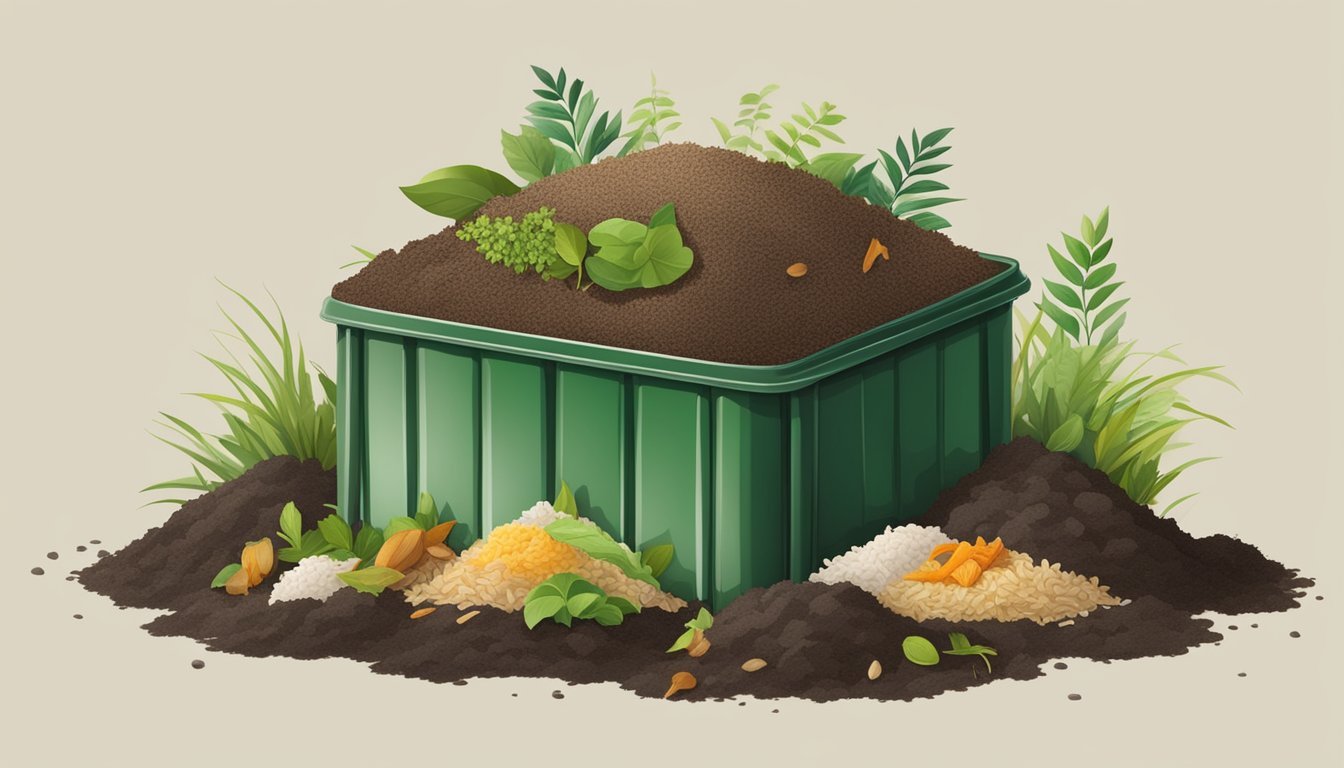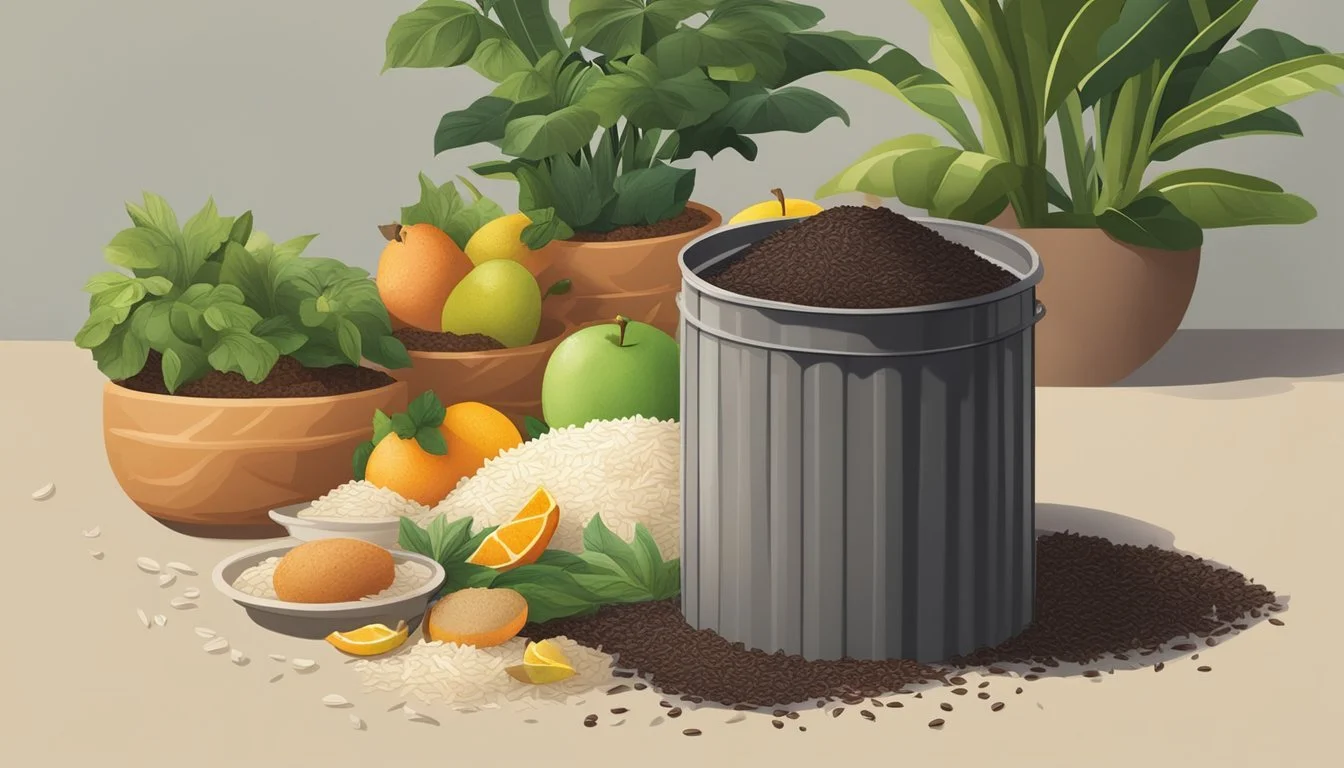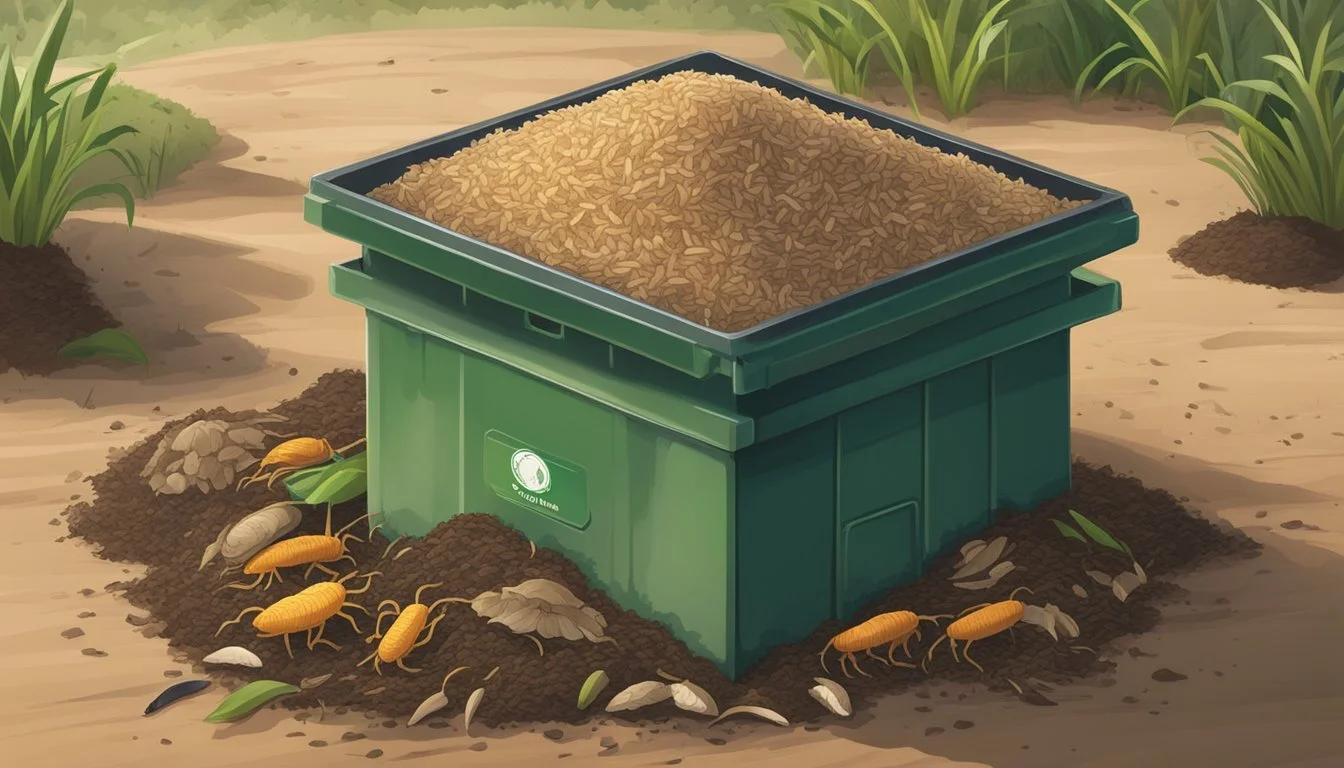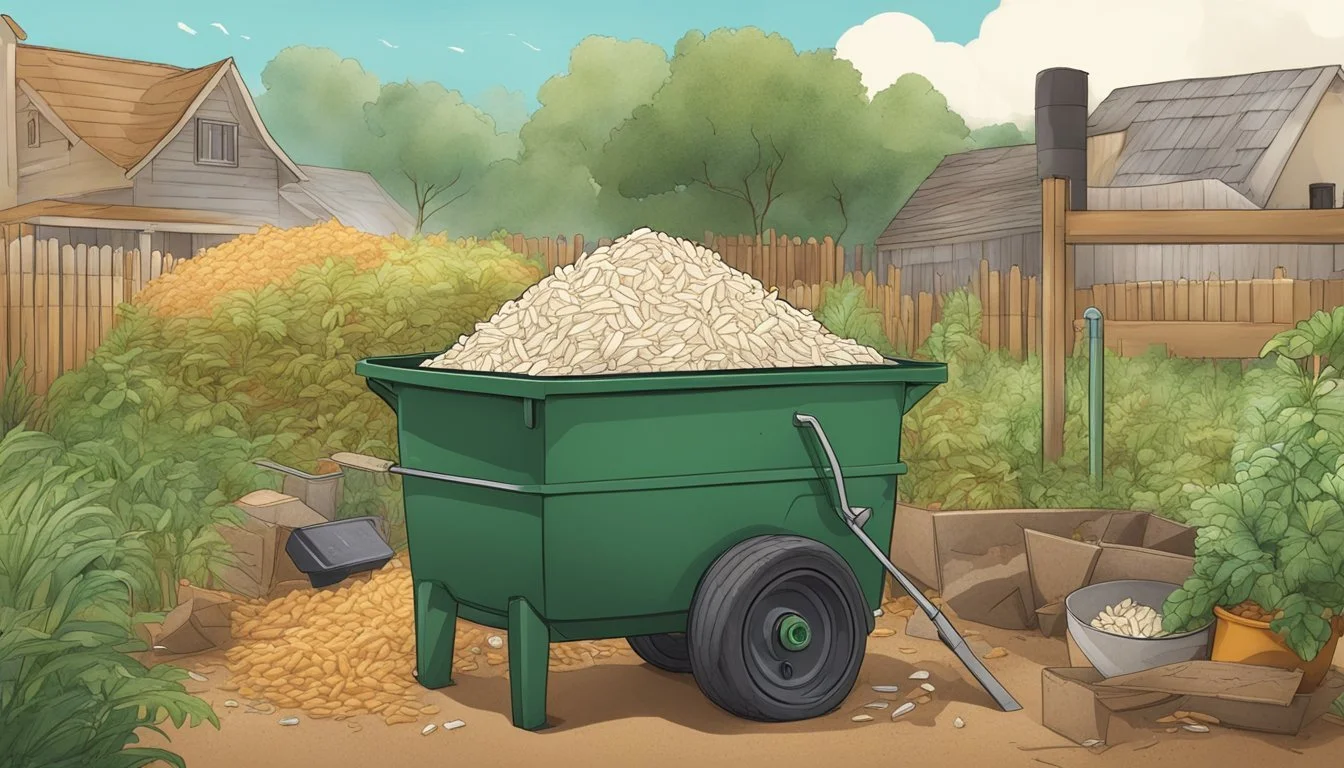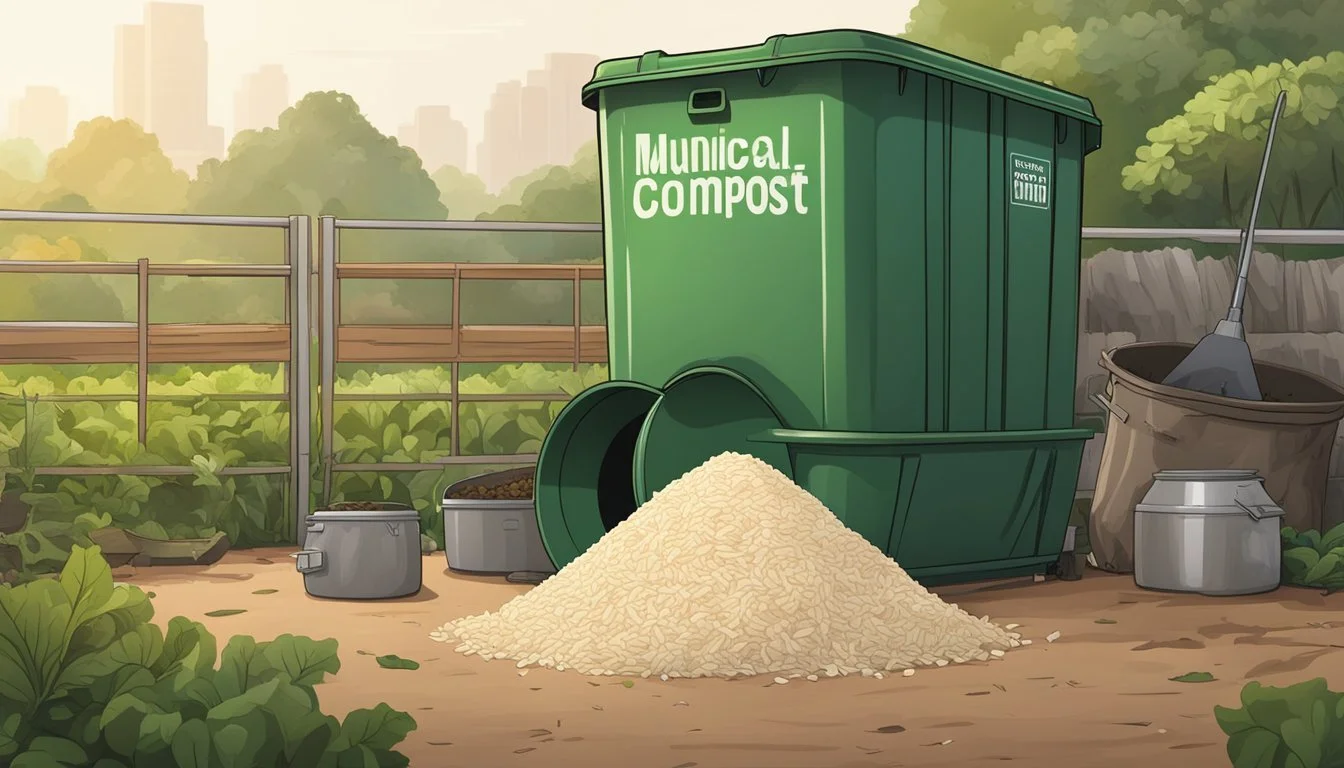Can You Compost Cooked Rice ?
Understanding the Pros and Cons
Cooked rice (What wine goes well with rice?) is a staple in many diets worldwide, and discerning individuals often seek environmentally friendly methods to dispose of leftovers. Composting, a process that transforms organic waste into nutrient-rich soil amendments, could be a suitable destination for cooked rice. Yet, the inclusion of cooked rice in compost bins is a nuanced subject warranting attention. While cooked rice is indeed biodegradable, care must be taken to ensure its addition to compost does not jeopardize the balance of the composting ecosystem.
The main concern when composting cooked rice lies in its propensity to attract unwanted pests and potentially harbor harmful bacteria. Therefore, anyone interested in composting cooked rice should consider the conditions of their composting setup. A hot composting system or a well-managed covered bin can facilitate the proper breakdown of rice without offering a breeding ground for pests or pathogens. It's crucial to add cooked rice in moderation to avoid upsetting the delicate microbial balance necessary for effective composting.
Understanding Composting Basics
In this section, we'll explore the fundamentals of composting and the advantages it brings to organic waste management. Readers will gain insight into how composting transforms waste into valuable soil amendment.
What is Composting?
Composting is a controlled process where microorganisms break down organic materials, such as leaves, vegetable scraps, and even cooked rice, into a nutrient-rich soil conditioner known as compost. The decomposition process is facilitated by ensuring a balance of 'greens' (nitrogen-rich materials) and 'browns' (carbon-rich materials) within a compost pile, along with adequate moisture, oxygen, and mixing.
Key components involved in composting:
Organic Waste: Includes food scraps, yard trimmings, and paper products.
Microorganisms: Bacteria, fungi, and other decomposers.
Aeration: Turning the pile to introduce oxygen.
Moisture: Necessary for microbial activity, but not excessively wet.
Carbon to nitrogen ratio (C): Ideally 30:1 for efficient decomposition.
Benefits of Composting Organic Waste
Composting offers numerous benefits to the environment and gardeners:
Reduces landfill waste: Diverting organic waste from landfills decreases methane emissions.
Enhances soil quality: Adding compost to soil improves its structure, fertility, and ability to hold water.
Recycles nutrients: Essential nutrients are returned to the soil, promoting plant growth.
Supports beneficial organisms: Compost supports organisms such as earthworms that are vital for healthy soil ecosystems.
By composting, they not only dispose of waste responsibly but also create a valuable product that supports plant growth and sustains soil health.
Can You Compost Cooked Rice?
Cooked rice can be composted, transforming kitchen waste into beneficial soil amendment. Yet, this practice is nuanced and requires specific conditions to be both effective and sanitary.
Cooked Rice in Composting
Cooked rice is an organic material, which in theory makes it suitable for composting. It contains carbohydrates that break down into simpler compounds, aiding the formation of nutrient-rich compost. When composting cooked rice, one should:
Add sparingly: Incorporate cooked rice into the compost pile in moderate amounts to avoid clumping and to maintain a balanced mix of green and brown materials.
Use hot composting methods: A hot compost pile, which reaches higher temperatures, can accelerate the decomposition process, reducing the chances of pest infestation and unpleasant odors.
Consider vermicomposting: Red wiggler worms in worm bins can efficiently process cooked rice. It is crucial to monitor the quantities fed to the worms, as excess can lead to molding issues.
Challenges with Rice Composting
While composting cooked rice is feasible, it presents certain challenges that composters should be aware of:
Attraction of pests: Cooked rice has a tendency to attract rodents and insects due to its odor and nutritional content.
Mold growth: Rice, with its high moisture content, is prone to mold growth, which can disrupt the balance of the compost pile.
Preventative measures include:
Proper aeration: Regularly turning the compost pile to provide oxygen and prevent anaerobic conditions, which favor mold growth.
Covered bins: Using a container with a lid can help protect the compost from pests while containing any unwelcome odors.
Composting Methods for Cooked Rice
Composting cooked rice can be a bit tricky due to its tendency to attract pests and mold. However, by utilizing the right approach, such as hot composting, vermicomposting, or Bokashi composting, one can safely add cooked rice to their compost systems.
Hot Composting Process
Hot composting involves maintaining a compost pile at higher temperatures to accelerate the breakdown of waste, including cooked rice. This high-temperature approach is effective at killing pathogens and deterring pests. For best results:
Maintain a temperature range of 130-160°F (55-71°C) within the compost pile to achieve optimal decomposition.
Balance the compost with appropriate browns (carbon-rich materials like dried leaves) and greens (nitrogen-rich materials, including kitchen scraps).
Cold Composting Considerations
Cold composting is a slower method that relies on the ambient microbial activity to break down materials, such as cooked rice. Important considerations:
Monitor the compost to ensure it does not become overly wet or smelly, as this can be indicative of improper balance.
Avoid adding large amounts of cooked rice; it should be done sparingly to prevent attracting vermin.
Vermicomposting with Cooked Rice
Vermicomposting utilizes red wiggler worms to transform organic matter into nutrient-rich castings. When adding cooked rice to a worm bin:
Moderation is key; Too much rice can lead to mold, which is harmful to worms.
Pre-mix the rice with other compostable materials to maintain a balanced diet for the worms.
Bokashi Composting
Bokashi composting is an anaerobic process that ferments organic waste, including cooked rice, instead of decomposing it. It's an effective method to handle kitchen waste because:
It requires a Bokashi bin which can be sealed to create an anaerobic environment.
Layer the cooked rice with Bokashi bran to accelerate the fermentation process.
Optimizing the Compost Environment
Creating an ideal composting environment requires precise management of components and conditions to break down organic matter efficiently and cleanly, including items like cooked rice.
Balancing Carbon and Nitrogen
The carbon to nitrogen ratio (C ratio) is pivotal in a compost bin. Carbon-rich materials (browns) like leaves or shredded paper should be paired with nitrogen-rich materials (greens) such as vegetable scraps or, in this case, cooked rice. The optimal balance is about 30 parts carbon to 1 part nitrogen. This ratio aids the microorganisms within the compost pile to work effectively and decompose materials without odor.
Maintaining Proper Moisture Content
Moisture is indispensable for microorganism survival in a compost bin. Moisture content should be maintained around 40-60% to enable decomposing processes without creating anaerobic conditions. One can feel the compost; it should be damp to the touch, similar to a wrung-out sponge, not soaked. A hot compost pile specifically should have consistent moisture to expedite decomposition and prevent unwanted bacteria that may be drawn to cooked rice.
Regulating Aeration and Temperature
Aeration speeds up the composting process by supplying oxygen to microbes and should be regulated to prevent excess moisture from fostering the growth of harmful bacteria. Turning the compost pile regularly ensures even aeration and prevents cold spots within the pile. Temperature is equally important, with a hot compost pile reaching between 135-160°F (57-71°C) for effective breakdown of materials like cooked rice. To maintain these conditions, regularly turn the compost and monitor temperature, preventing the risk of pest attraction and promoting faster decomposition.
Preventing Common Composting Problems
While composting cooked rice, one should pay attention to managing pests and maintaining proper aeration to avoid common issues such as rodent attraction and anaerobic conditions.
Avoiding Attraction of Rodents and Pests
Composting cooked rice can attract unwanted rodents and pests to the compost pile if not done cautiously. To mitigate this risk:
Add Rice Sparingly: Mix rice into the compost in small amounts to minimize odors that attract pests.
Use a Covered Bin: A closed compost bin with a secure lid helps to deter animals.
Layer Carefully: Place rice beneath "brown" compost materials like dry leaves or straw, which help to obscure it from pests.
Maintain Cleanliness: Keeping the composting area tidy and free from spilled food can reduce pest interest.
Handling Anaerobic Conditions
Anaerobic conditions in a compost pile result from insufficient air circulation, often leading to foul odors and slowed decomposition. To promote aerobic decomposition:
Turn the Compost: Regularly turning the compost will aerate the pile, helping to maintain oxygen levels and prevent anaerobic conditions.
Balance Green and Brown Materials: Ensure a good balance between nitrogen-rich "green" material and carbon-rich "brown" material to facilitate airflow.
Avoid Overwatering: Excess moisture can lead to compaction and reduced oxygen, so water sparingly.
Consider a Bin with Air Vents: Using a covered bin designed with built-in air vents can maintain air circulation even when the bin is closed.
Addressing Specific Types of Cooked Rice
When composting cooked rice, one must consider the particular type of rice and any additional ingredients it may contain, as these factors can influence the composting process.
Composting White vs Brown Rice
White Rice: White rice typically has a higher starch content compared to brown rice. This starch, when added to compost, can create a dense, sticky environment which may slow down the composting process. Therefore, it's important to add white rice in small amounts and mix thoroughly with other compost materials to enhance aeration.
Brown Rice: Brown rice is generally richer in nutrients than white rice and includes fibrous bran, which can benefit the compost by adding more structure to the pile. Similar to white rice, it should be added in moderation and interspersed with high-carbon "browns" to maintain a balanced compost.
Dealing with Flavored or Spiced Rice
Flavored Rice: Cooked rice that has been flavored or includes additives should be composted with caution. The spices and additional flavorings can attract unwanted pests to the compost pile. If one chooses to compost this type of rice, it should be done conservatively and well buried within the center of the compost heap to discourage pest interest.
Spiced Rice: Spiced rice often contains potent aromatic compounds that could attract vermin or cause imbalances in the microbial community within the compost. One should ensure that the rice is thoroughly mixed with other organic materials in the pile to dilute and balance out the presence of these spices.
Enhancing Soil Quality with Rice Compost
Composting rice can contribute significantly to soil enhancement by adding nutrients and minerals that plants need to thrive. The inclusion of rice in a compost mixture introduces starches and carbohydrates, which are beneficial as they break down and enrich the soil.
When incorporating cooked rice into compost, one should use a compost bin to better control conditions and mitigate risks such as pest attraction. Here's how to do it effectively:
Balance: Ensure the compost has a balanced mix of 'green' materials like rice and 'brown' components like dry leaves or paper.
Moisture: The compost should maintain a moisture level similar to a wrung-out sponge. Excess moisture can lead to mold, while too little hinders decomposition.
Moisture Level Description Too Wet May cause odor and mold Ideal Like a wrung-out sponge Too Dry Slows down decomposition
Aeration: Regular turning of the compost ensures oxygenation, which is crucial for breaking down rice efficiently.
When rice compost is used as fertilizer, it boosts the soil structure and fertility. It provides a slow-release of nutrients, making it a substantial additive to garden soil, particularly for plants that require a lot of carbohydrates. This supplementation can, in turn, lead to more robust plant growth and increased microbial activity in the soil.
In summary, the methodical composting of rice can be a valuable part of a garden's nutrient recycling system, enhancing soil quality and contributing to a more sustainable planting cycle.
The Role of Leftover Rice in Composting
Including leftover rice in a compost pile can be beneficial but necessitates certain precautions to prevent pests and ensure proper decomposition.
Composting Leftover Rice Safely
To compost cooked rice effectively, one should ensure that the rice is cooled down to room temperature before adding it to the compost to prevent the growth of harmful bacteria. It is advisable to incorporate rice sparingly into the pile and mix it well with other compostable materials to enhance aeration and hasten decomposition. Using a hot compost system or a covered bin can also help mitigate the risk of attracting rodents and other pests. Leftover rice should be treated as a green compost matter (rich in nitrogen) and thus needs to be balanced with brown compost matter (rich in carbon) like dry leaves, straw, or sawdust.
Utilizing Stale Leftover Rice
Stale leftover rice can be particularly suitable for worm bins (vermicomposting). Red wiggler worms can efficiently process stale rice into nutrient-rich castings. However, it is essential to control the quantity of rice fed to the worms to avoid overloading the system and preventing mold. The following table outlines the appropriate steps for adding stale rice to a worm bin:
Step Action 1. Quantity moderation Moderation is key; add small amounts incrementally. 2. Material preparation Break down or moisten rice to facilitate easier consumption by worms. 3. Balance with other scraps Ensure a balanced diet for the worms with varied organic waste. 4. Monitor for potential mold Observe the worm bin for any signs of mold and adjust feed accordingly.
Guidelines for Adding Rice to Compost
Adding cooked rice to compost is possible, but it requires careful management to avoid attracting pests and promoting bacterial growth. The reader will learn how to compost rice safely and efficiently with the following guidelines.
Precautions When Composting Rice
Pest Control: Rice, especially when cooked, can attract rodents and other pests. To prevent this, one should either compost rice in a covered bin or ensure it's well mixed into the center of the compost pile, away from easy access.
Bacterial Growth: Unchecked, rice can harbor harmful bacteria. It's critical to let rice cool to room temperature before adding it to compost to minimize this risk.
Best Practices for Rice Composting
Moderation: Include rice in small amounts to keep the compost balanced and not overwhelm the system with materials that can cause issues if added in large quantities.
Aeration: Turn the compost regularly to provide oxygen, which aids in breaking down the rice and maintains a healthy compost process.
By adhering to these specific guidelines, one can successfully integrate rice into their composting routine without adverse effects.
Special Considerations for Different Rice Varieties
Composting rice requires attention to detail due to its potential for attracting pests and the differences in decomposition rates among various types of rice.
Basmati, Arborio, and Jasmine Rice
Basmati, Arborio, and Jasmine rices are popular varieties that share some commonalities in their composting process. Being generally high in starch, they can attract pests if not managed properly. When composting these varieties:
Basmati Rice: Should be added in moderate amounts to prevent clumping and expedite the aerobic decomposition process.
Arborio Rice: Has a creamier, stickier texture after cooking, which can lead to dense, non-aerated clumps in compost piles; thorough mixing and occasional turning are recommended.
Jasmine Rice: Often leaves a fragrant residual, which might attract more insects; burying it deep within the compost can mitigate this issue.
Can Uncooked Rice be Composted?
Uncooked rice can be composted, but there are specifics to consider:
Uncooked rice decomposes slower than cooked rice and should be added sparingly to avoid attracting rodents or creating anaerobic pockets.
It can contribute to the formation of harmful bacteria if the pile is not kept at proper temperatures; therefore, monitoring and maintaining the compost pile temperature is essential.
Composting Errors to Avoid with Cooked Rice
When incorporating cooked rice into a compost heap, it's important to avoid several common mistakes that can hinder the decomposition process or attract pests.
Overloading the Pile: An excessive amount of cooked rice can lead to compaction and poor aeration within the compost heap. Composters should add rice in small quantities to maintain a balanced mix of green and brown materials.
Adding rice to a compost bin without considering pest control measures may attract rodents and other pests. It's crucial to ensure the compost is well-covered or use a bin with a secure lid.
Composters often overlook the importance of maintaining the right temperature in their piles. Rice decomposes more efficiently in a hot composting environment. A cold heap may result in the rice not breaking down appropriately, potentially causing odor issues.
Mixing the Rice Thoroughly: Simply placing rice on top of the compost pile is inefficient. It should be mixed into the middle of the compost to facilitate breakdown and to obscure it from pests.
Lastly, rice in compost piles may harbor bacteria if not handled correctly. To avoid this, one should ensure:
Do's Don'ts Mix rice in well Leave rice on the surface Add sparingly Overload with too much rice Cover the pile Leave pile uncovered Monitor for pests Ignore signs of vermin or pests
By avoiding these mistakes, composters can ensure that the added cooked rice will decompose properly and enrich the resulting compost, rather than causing problems that could have been easily prevented.
Alternative Uses for Cooked Rice in Gardening
Cooked rice, aside from being a potential green compost ingredient, offers several unique applications in gardening. While it should be incorporated moderately to prevent attracting pests, it can serve multiple beneficial purposes when used with care.
In Soil Amendment: Cooked rice is rich in starch, providing a source of energy for soil microbes. Gardeners may mix small quantities into the soil to enhance microbial activity, which, in turn, improves soil structure and fertility.
As a Mulch: Some gardeners use cooked rice sparingly as a mulch to add a light layer of organic matter. This can help retain soil moisture and gradually decompose, adding nutrients back into the soil.
For Seed Germination: Cooked rice can help in seed germination by maintaining moisture around seeds. Its absorptive properties ensure a humid environment conducive to sprout development.
The table below sums up the uses and considerations for using cooked rice in gardening:
Use in Gardening Benefits Considerations Soil Amendment Enhances microbial activity, Improves soil fertility Use sparingly to avoid pest attraction Mulch Helps retain soil moisture, Slowly adds nutrients Apply thinly to prevent mold growth Seed Germination Maintains moisture for seeds, Supports sprout development Monitor to prevent fungal growth
Gardeners finding themselves with excess cooked rice may consider these alternative uses. However, they should remain vigilant about the quantity used and the potential for unwanted pests and diseases. Cooked rice is biodegradable and when integrated correctly, can contribute to a garden's ecological cycle.
Leveraging Municipal Compost Systems
Municipal compost systems provide residents an opportunity to compost organic materials, including cooked rice, through local facilities. These systems are designed for mass processing and can handle various organic waste streams that individual backyard composts may not manage effectively.
Advantages of Using Municipal Compost Systems:
They possess the capability to reach higher temperatures, which accelerates the breakdown of cooked rice and reduces the risk of attracting pests.
Municipal systems often implement controlled environments that balance moisture and aeration, conditions that are crucial for composting cooked rice without encouraging bacterial growth.
Residents can contribute to their local municipal compost without the worry of managing the composting process themselves.
How to Utilize Municipal Compost Systems:
Check Local Guidelines: Always verify what materials your local municipal compost system accepts. Most systems have specific guidelines concerning cooked foods.
Prepare Rice for Composting: Ensure that rice is free from oils, sauces, and other non-compostable contaminants.
Use Certified Compostable Bags: If required, deposit rice in certified compostable bags to facilitate the collection and composting process.
Drop Off at Local Facilities: Bring your compostable materials, including cooked rice, to designated drop-off points or use curbside collection services if available.
Residents can play a pivotal role in waste management by participating in municipal composting. One should utilize these systems to contribute to broader environmental benefits, like reducing landfill waste and creating nutrient-rich soil amendments for community use.
Advanced Topics in Rice Composting
While composting rice is largely a simple process, certain advanced considerations can enhance the efficiency and outcome. Two key aspects involve understanding the role of urea and the dynamics of composting microorganisms.
Impact of Urea on Rice Composting
Urea, a nitrogen-rich compound, can be a significant asset to rice composting. When added to compost, it accelerates the breakdown of organic matter.
Role in Decomposition: Urea decomposes into ammonia and carbon dioxide, which increase microbial activity and, subsequently, the rate of composting.
Nitrogen Content: It enriches the compost with nitrogen, an essential nutrient for plant growth.
However, the addition of urea must be carefully managed. An excess can lead to ammonia volatilization and a decrease in compost quality.
Influence of Composting Microorganisms
Microorganisms are paramount to composting. For rice, which can be dense and moist, the choice of microorganisms can determine the success of the composting process.
Key Microorganisms:
Aerobic bacteria: Break down carbohydrates and proteins, producing heat.
Fungi: Assist in degrading complex carbohydrates found in rice.
Actinomycetes: Play a role in breaking down organic matter into humus.
These microorganisms require a balance of moisture, temperature, and oxygen to thrive. An imbalance could hinder the process and result in issues such as bad odors or the attraction of pests.
Conclusion
Composting rice, especially cooked rice, is possible but requires careful management within the compost environment. Cooked rice tends to attract pests and can also lead to unpleasant odors due to its propensity for rapid bacterial growth.
When considering adding cooked rice to a compost pile or bin, gardeners should implement the following steps:
Quantity: Add small amounts of cooked rice to the compost to prevent attracting rodents and pests.
Compost Condition: Place rice in a hot compost pile or a covered bin to accelerate decomposition and deter animals.
Mixing: Thoroughly mix the rice with other compost materials to avoid clumping, which can hamper airflow and slow down the composting process.
One should also remember that while rice is an organic material and eventually breaks down, its rate of decomposition can be slower than other compost ingredients. Therefore, understanding and maintaining the right conditions in the compost bin or pile is crucial for the successful incorporation of cooked rice into compost.
By carefully managing factors such as quantity, bin condition, and thorough mixing, individuals can successfully enrich their compost with the additional organic matter provided by cooked rice, thus contributing towards a nutrient-rich soil amendment for gardening use.

